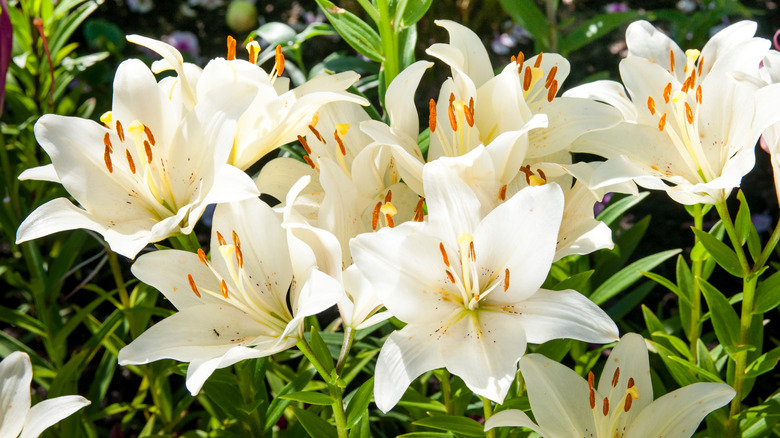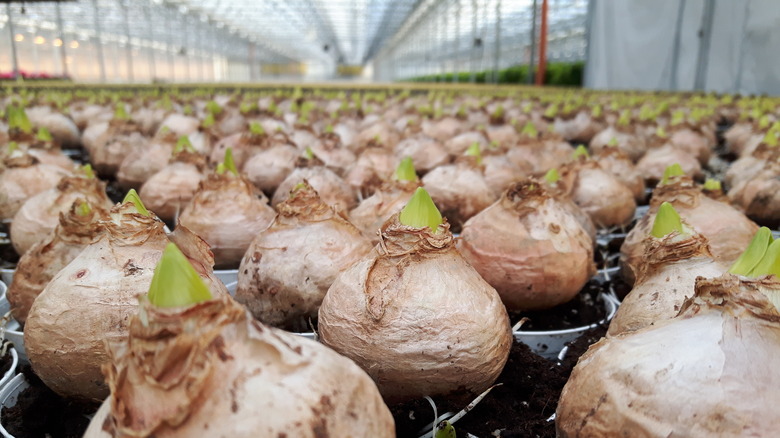What's The Secret For Getting Easter Lilies To Bloom?
From egg hunts to rabbits and flowers, many modern-day themes of Easter have their roots in Ostara, a pagan holiday centered around springtime, rebirth, and renewal. In the Bible, white lilies are also associated with purity, renewal, and resurrection so they quickly became an obvious answer for how to decorate the home for Easter. When you start seeing these white blooms advertised by florists, nurseries, and grocery stores, you know that the springtime holiday is just around the corner! Every year, Easter lily growers must carefully plan when to grow, harvest, and ship their lilies because the exact date of Easter can vary from year to year. Planting Easter lilies in your garden can be easy, but timing them just right so they'll bloom over Easter can prove somewhat of a challenge. The secret to getting Easter lilies to bloom when you want them to is to plant them about 120 days before the holiday.
Of course, ensuring that your Easter lilies bloom around Easter is more than just a matter of timing; you also need to make sure that your plants are happy and healthy, with all the proper nutrients and environmental conditions. Here's how to get beautiful Easter lily blooms this spring, and some professional growing tips to get the timing and the blooms themselves just right.
Commercial growers use clever techniques
Easter lilies take just about four months from when they're first planted to reach full bloom, so if you want blooms on Easter Sunday, you'll need to do a little simple math. Because Easter's date varies each year, you'll want to begin thinking about planting your lilies in late November/early December. We don't tend to think of such a springtime holiday in the thick of winter, but planning ahead will give your garden gorgeous blooms just in time. Once an Easter lily flower completely opens, it will only last a few days before it starts to wilt and fall off. However, the plant will usually keep producing blooms for up to two weeks, as long as temperatures remain cool and mild. You can use the knowledge to your advantage by planting the Easter blooms a little early, especially if spring weather tends to be quite warm in your area.
Sometimes, commercial growers also use special greenhouse conditions to manipulate the flowers into blooming at the right time. After the bulbs are planted in the ground, Easter lilies need to experience about six weeks of cold temperatures in order to trigger growth and blooming (hence why planting in early December is a safe bet). If you have a refrigerator in your garage or room in your kitchen fridge, you're in luck! Plant the bulbs in containers, then place them in a fridge between 40 to 45 degrees Fahrenheit for about four to six weeks. Afterward, move the baby lilies to a sunny yet cool area below 65 degrees Fahrenheit, and they'll reach full bloom in about 35 days!
Growing and displaying Easter lilies
Easter lilies are usually grown from bulbs, and can thrive in either garden soil or containers, but many people find containers easier to grow in because they have good drainage, a necessity for healthy lilies. Plant the bulbs about 4 to 6 inches deep in the soil, with at least a foot of space between them so they'll have plenty of room to grow. As your Easter lilies start to get taller, you may need to add supports to keep the top-heavy stems from bending and falling over. Once the flower buds have started to form, you can fertilize the plant with a high-phosphorous fertilizer to give the blooms an extra boost. Prune the plant back down to the ground in fall to encourage regrowth in spring.
If you want to harvest your homegrown Easter lilies and keep them in a vase during Easter, be sure to properly prepare and care for them to keep the blooms looking fresh for weeks. Trim the flower stems at a 45 degree angle and change the water every few days. Displaying your Easter lilies in a cool area of the home will also help them last, so avoid sunny windows, humid bathrooms, or radiators. Remember that Easter lilies are extremely poisonous to cats, so some people may want to avoid these houseplants that should never be grown in a home with pets.


